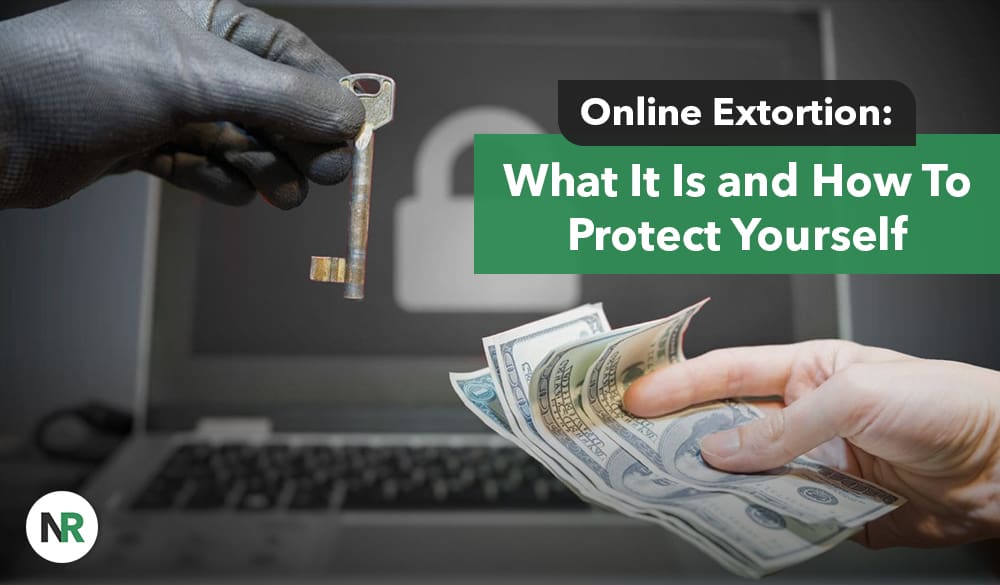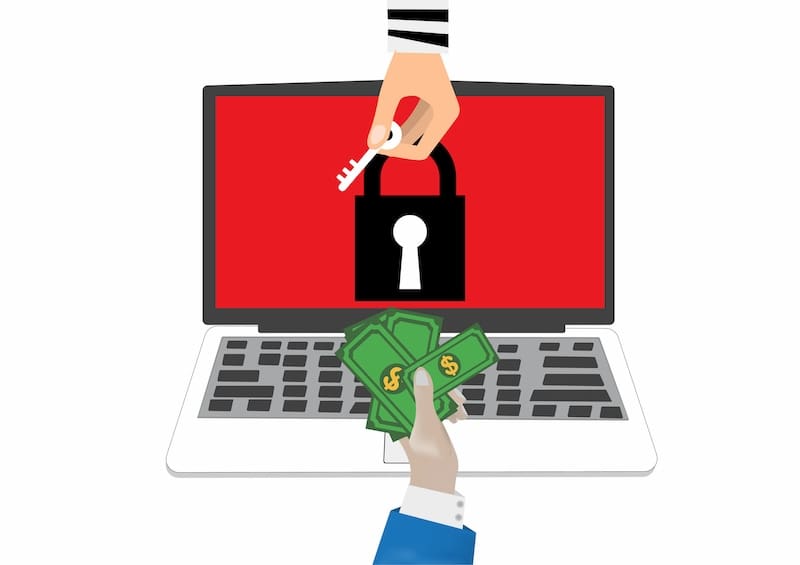This article discusses online extortion strategies and how to keep yourself safe from cybercriminals.
Today, there are all types of cybercrimes, including cyberstalking hacking, identity theft, phishing and more. The list also includes cyber extortion, which is sometimes referred to as online blackmail.
Practically anyone can become a victim of cyber extortion. The good news is that there are ways to protect yourself and prevent this from happening in the first place.
And if the worst happens, there are ways to get through it and rebuild your online reputation in the aftermath.
Let’s get into it. To speak with an online reputation expert immediately, give us a call at 844-461-3632 for a free consultation.
What Is Online Extortion?
Cyber extortion is when cyber criminals threaten to expose a person’s sensitive information, including images and videos, unless the victim meets the cyber extortionists’ demands.
Sometimes, the cyber extortionist will actually have the information they claim to have. Other times, it’s a bluff to get you to comply even though they don’t have anything to back up their claims.
For example, a cyber extortionist may insist on a large money transfer, or else your bank account information will go public. Other threats may include:
- Damage to personal property, including online and physical assets
- Releasing private information that can ruin a person’s reputation
- Violent acts against loved ones
The only difference between offline blackmail and online blackmail is that cyber blackmail takes place in a digital space. However, it will still cause serious, real-world damage to the victim.
One of the most insidious aspects of cyber extortion is that information can spread much more quickly than in the offline world. An online blackmail event can become public knowledge fast. Plus, cyber extortionists are able to spread the victim’s personal information around quickly since everything takes place online.
More often than not, the cyber extortionist is someone who’s well-versed in digital technology and hacking. They’ll be able to get around online security infrastructures quickly, leaving you vulnerable to whatever they’re in the mood to do.
What To Do If You’re the Victim of Online Blackmail
If you’re the victim of cyber extortion, it can be nearly impossible to think clearly. Staying calm and making thoughtful decisions is extremely difficult.
Unfortunately, that’s exactly what cyber criminals count on when they contact you. They expect you to act fast and make rash decisions because you’re so concerned with the potential outcome if you don’t comply right away.
The best approach is to slow down, think clearly and follow these steps. After all, so much of what cyber attackers say is false, and they use clever tactics to keep you from making wise decisions.
Do Not Engage With Cyber Criminals
Whatever you do, do not continue communicating with the blackmailer.
Every single interaction you have with them gives them a bit more power, control and information to use against you. You’ll essentially prove to the blackmailer that you can be exploited and manipulated.
The more contact you have with them, the more likely it is that your engagement will escalate and worsen.
By stopping all communication, you reduce the amount of contact you have with the blackmailer. And even if that doesn’t solve the problem entirely, it gives you some time to think about your next steps.
This doesn’t mean you’re going to ignore the situation, just that you’ll discontinue speaking with the attacker while you work on solving the problem.
Keep a Record of All Communication
Next, you need to gather, save and catalog any and all contact you’ve had with the blackmailer. Every single bit of proof will count in a cyber extortion case. Nothing is too small to keep, so don’t assume that something is unimportant and won’t be of help.
Take screenshots of all interactions with the blackmailer, including emails, text messages, and any other modes of communication.
Additionally, highlight any personal information that was mentioned during the exchanges. That includes information about the criminal and about you.
For example, if the cyber criminal alluded to a social media platform they’re on or a screen name they use, highlight it. This can help the authorities figure out where this individual spends their time online and who they are.
Similarly, if they mention personal information about you, like your email address or banking information, highlight it in your documentation. This can provide insight into where and how they attained your sensitive information.
Report the Incident
Once you’ve built a file of evidence, cyber extortion attacks should always be reported to the authorities. Start by calling your local police department. They may be able to help you, or they’ll point you to the right contact to report your case.
Most law enforcement agencies have a process that they follow in a cyber blackmail case. You’ll likely have to fill out a form with your personal info and submit it along with your evidence.
Prevent Future Cyber Extortion Attacks
In the next section, we’ll discuss keeping yourself safe from digital blackmail occurring again. Prevention methods include:
- Improving your online security
- Adjusting online privacy settings
- Spotting common blackmail tactics early
- Removing your personal info from online sites
When you know how to protect against and recognize targeted attacks like phishing emails, malicious software and ransomware attacks, among other threats, it’s easier to not fall victim to them.
How To Prevent Cyber Extortion Attacks
It’s always better to prevent scams or threats from happening in the first place than to try to rebound when one occurs. Here are the best ways to keep online threats at bay.
Improve Your Online Security
The most effective way to prevent online threats is to tighten up your online security. Here are a few ways to be more secure online:
- Create strong passwords that are difficult to guess.
- Change your passwords regularly.
- Never use the same password twice. Create a unique password for every account you have to log in to.
- Set up two-factor authentication. After signing in, you’ll be prompted to enter a code that’s texted or emailed to you for an extra layer of safety.
- Make sure your apps and software are always up to date.
Limiting how much information others can find out about you and access means that hackers will move on to someone who has less stringent security.
Be Purposeful About Your Social Media Use
Many people fall victim to cyber extortion because someone accessed their personal information. Sensitive data is the best tool that criminals have to use against you.
Social media is an excellent platform for researching individuals. The more you share on social media, the more data there is for hackers to gather and use against you.
Here are a few ways to stay safer on social media:
- Set your profile to private. This will make it much more difficult for hackers and people you don’t know to see your content.
- Don’t connect with people who you don’t know.
- Limit the amount of information you share on social media. This includes what you post to your feed and the conversations you have on DM.
Keep in mind that even if you’ve connected with someone elsewhere online, like a dating site or another social platform, they may not be 100% safe. To prevent cyber extortion, keep your private information to yourself when using online platforms.
Remove Your Information From Data Broker Sites
Data broker sites and people search websites gather all sorts of private information about individuals and make it accessible in searchable online directories. Having so much information about you online makes it easy for hackers to access it.
You’d be shocked at how much data can be found about you online. In addition to your contact information, you can find private info related to your bank accounts, real estate, family members, criminal history, and so much more.
It’s always best to remove your information from all of the data broker sites it’s listed on. This can be a time-consuming and frustrating process, though.
First, you’ll need to find where your information is listed. Then, you’ll have to remove your data from each site one by one. Some sites have secretive removal methods, and they may not even follow through with removal in the end. You’ll also need to ensure your info doesn’t reappear on those sites, which is common.
Instead of handling this yourself, you can hire a content removal team to do it for you. Speak with one of our data removal specialists today at 844-461-3632 to learn about our services.
Recognize Common Cyber Extortion Scams
It’s important to know what to watch out for so you can prevent a blackmail threat. If you don’t know about basic blackmail scams, it’s much easier to believe what hackers say and give in to their demands without thinking twice.
Below are examples of a few types of digital blackmail scams that are far too common.
In many cases, the hackers are lying about the information they have. Commonly, it’s all a lie intended to scare the victim and get them to act fast without doing any research first.
Example 1: Sextortion
The attacker sends the victim an email that says malware has been installed on an adult website and the victim’s password has been stolen. The attacker says that the victim has been recorded via a webcam while using the adult website. To keep the video of the victim private, the attacker demands a large amount of Bitcoin or money. If the victim does not pay the attacker on time, the threat is that the video will be shared with all of the victim’s online contacts.
Example 2: Tax Evasion Threat
The attacker sends an email to the victim that says their computer was hacked. The attacker says that documents were found that show the victim has hidden information from the IRS. In order to keep the documents from being released, the attacker demands money. Sometimes, the attacker will also threaten to infect the victim’s computer with ransomware if they don’t comply.
A similar threat is when the attacker poses as an IRS agent. They say that you have to pay a certain amount of money to avoid legal trouble.
Example 3: DDoS Attack Threat
An attacker contacts a small business owner and says they’ll launch a large-scale DDoS attack if they don’t comply with their demands. Sometimes, a small, short-term DDoS attack is launched to convince the victim that the threat is serious (even though it’s typically not).
DDoS stands for “Distributed Denial-of-Service.” This type of attack sends so much traffic to a website that it becomes inaccessible to anyone else. This can cause financial and reputational losses for the website owner.
Protect Yourself From Cyber Extortion and Damage To Your Online Reputation
Anybody can fall victim to cyber extortion. At best, dealing with an online scammer can be annoying and time-consuming. In the worst-case scenario, cyber criminals can expose your sensitive information or attack your business, ruining your digital reputation.
If you’ve been the victim of digital blackmail and you need to rebuild your personal or brand reputation as a result, our online reputation management (ORM) team can help.
Contact us today at 844-461-3632 or by filling out the form below for a free consultation.









